Valorization of Uruguayan Pinus elliottii Bark by Developing Sustainable Adhesives
Abstract
1. Introduction
2. Materials and Methods
2.1. Pine Bark
2.2. Extraction on Laboratory Scale
2.2.1. Total Polyphenol Content
2.2.2. Condensed Tannin Content
2.2.3. Stiasny Number
2.3. Extraction on a 1 L (L) Scale
2.3.1. Average Molecular Weight Distribution by GPC
2.3.2. FTIR Analysis
2.4. Extraction on a 50 L (L) Scale
2.5. Adhesive Formulation
2.5.1. Rheological Behavior and Useful Life
2.5.2. Differential Scanning Calorimetry (DSC)
2.5.3. Automated Bonding Evaluation System (ABES)
2.6. Energy Content and Ash Composition of Pinus elliottii Engelm Bark
2.7. Statistical Analysis
3. Results and Discussion
3.1. Extraction on a Laboratory Scale
Optimization of Conditions
3.2. Extraction on a 1 L (L) Scale
Molecular Weight Distribution of the Extract Obtained at 65 °C
3.3. Extraction at 50 L
3.4. Characterization of Adhesive Formulations
3.4.1. Rheological Behavior
3.4.2. DSC Analysis
3.4.3. Adhesive Testing (ABES)
3.5. Energy Content of Ash Content of the Bark
4. Conclusions
Author Contributions
Funding
Data Availability Statement
Acknowledgments
Conflicts of Interest
References
- Thorenz, A.; Wietschel, L.; Stindt, D.; Tuma, A. Assessment of agroforestry residue potentials for the bioeconomy in the European Union. J. Clean. Prod. 2018, 176, 348–359. [Google Scholar] [CrossRef] [PubMed]
- Tahir, P.M.; Halip, J.A.; Lee, S.H. Tannin-based bioresin as adhesives. In Lignocellulose for Future Bioeconomy; Elsevier: Amsterdam, The Netherlands, 2019; pp. 109–133. [Google Scholar]
- Meyer, V.; Basenko, E.Y.; Benz, J.P.; Braus, G.H.; Caddick, M.X.; Csukai, M.; de Vries, R.P.; Endy, D.; Frisvad, J.C.; Gunde-Cimerman, N.; et al. Growing a circular economy with fungal biotechnology: A white paper. Fungal Biol. Biotechnol. 2020, 7, 1–23. [Google Scholar] [CrossRef] [PubMed]
- Dieste, A.; Cabrera, M.N.; Clavijo, L.; Cassella, N. La Bioeconomía Forestal en Uruguay Desde Una Perspectiva Tecnológica; Universidad de la República: Montevideo, Uruguay, 2019. [Google Scholar]
- Santos, J.; Pereira, J.; Ferreira, N.; Paiva, N.; Ferra, J.; Magalhães, F.D.; Martins, J.M.; Dulyanska, Y.; Carvalho, L.H. Valorisation of non-timber by-products from maritime pine (Pinus pinaster, Ait) for particleboard production. Ind. Crops Prod. 2021, 168, 113581. [Google Scholar] [CrossRef]
- Wang, Z.; Burra, K.G.; Zhang, M.; Li, X.; Policella, M.; Lei, T.; Gupta, A.K. Co-pyrolysis of waste tire and pine bark for syngas and char production. Fuel 2020, 274, 117878. [Google Scholar] [CrossRef]
- Arias, A.; Entrena-Barbero, E.; Feijoo, G.; Moreira, M.T. Sustainable non-isocyanate polyurethanes bio-adhesives for engineered wood panels are revealed as promising candidates to move from formaldehyde-based alternatives. J. Environ. Chem. Eng. 2022, 10, 107053. [Google Scholar] [CrossRef]
- Park, C.; Lee, S.; Lee, J. Energy recovery from wood pellets and waste mulching film with minimization of harmful byproducts via thermochemical conversion with CO2 agent. Chem. Eng. J. 2022, 427, 131459. [Google Scholar] [CrossRef]
- Abilleira, F.; Varela, P.; Cancela, Á.; Álvarez, X.; Sánchez, Á.; Valero, E. Tannins extraction from Pinus pinaster and Acacia dealbata bark with applications in the industry. Ind. Crops Prod. 2021, 164, 113394. [Google Scholar] [CrossRef]
- García, D.E.; Fuentealba, C.A.; Salazar, J.P.; Pérez, M.A.; Escobar, D.; Pizzi, A. Mild hydroxypropylation of polyflavonoids obtained under pilot-plant scale. Ind. Crops Prod. 2016, 87, 350–362. [Google Scholar] [CrossRef]
- Santos, J.; Delgado, N.; Fuentes, J.; Fuentealba, C.; Vega-Lara, J.; García, D.E. Exterior grade plywood adhesives based on pine bark polyphenols and hexamine. Ind. Crops Prod. 2018, 122, 340–348. [Google Scholar] [CrossRef]
- Besserer, A.; Troilo, S.; Girods, P.; Rogaume, Y.; Brosse, N. Cascading recycling of wood waste: A review. Polymers 2021, 13, 1752. [Google Scholar] [CrossRef]
- Ministry of Livestock, Agriculture and Fisheries, General Forestry Directorate. “Forest Cartography Results 2021”. Available online: https://www.gub.uy/ministerio-ganaderia-agricultura-pesca/comunicacion/publicaciones/cartografia-nacional-forestal-2021 (accessed on 4 April 2022).
- Xavier, L.; Barrenengoa, M.; Dieste, A.; Amilivia, A.; Palombo, V.; Sabag, M.; Zecchi, B. Valorization of Pinus taeda bark: Source of phenolic compounds, tannins and fuel: Characterization, extraction conditions and kinetic modelling. Eur. J. Wood Wood Prod. 2021, 79, 1067–1085. [Google Scholar] [CrossRef]
- da Silva Araujo, E.; Lorenço, M.S.; Zidanes, U.L.; Sousa, T.B.; da Silva Mota, G.; de Oliveira Reis, V.D.N.; Gomes da Silva, M.; Mori, F.A. Quantification of the bark Myrcia eximia DC tannins from the Amazon rainforest and its application in the formulation of natural adhesives for wood. J. Clean. Prod. 2021, 280, 124324. [Google Scholar] [CrossRef]
- Pizzi, A. Tannins: Major sources, properties and applications. In Monomers, Polymers and Composites from Renewable Resources; Elsevier: Amsterdam, The Netherlands, 2008; pp. 179–199. [Google Scholar]
- Shirmohammadli, Y.; Efhamisisi, D.; Pizzi, A. Tannins as a sustainable raw material for green chemistry: A review. Ind. Crops Prod. 2018, 126, 316–332. [Google Scholar] [CrossRef]
- Boussetta, A.; Ablouh, E.H.; Benhamou, A.A.; Taourirte, M.; Moubarik, A. Valorization of Moroccan brown seaweeds: Elaboration of formaldehyde-free particleboards based on sodium alginate–corn-starch-Mimosa tannin wood adhesives. Int. J. Adhes. Adhes. 2021, 108, 102894. [Google Scholar] [CrossRef]
- Vázquez, G.; González-Alvarez, J.; Santos, J.; Freire, M.S.; Antorrena, G. Evaluation of potential applications for chestnut (Castanea sativa) shell and eucalyptus (Eucalyptus globulus) bark extracts. Ind. Crops Prod. 2009, 29, 364–370. [Google Scholar] [CrossRef]
- Chupin, L.; Motillon, C.; Charrier-El Bouhtoury, F.; Pizzi, A.; Charrier, B. Characterisation of maritime pine (Pinus pinaster) bark tannins extracted under different conditions by spectroscopic methods, FTIR and HPLC. Ind. Crops Prod. 2013, 49, 897–903. [Google Scholar] [CrossRef]
- Saad, H.; Khoukh, A.; Ayed, N.; Charrier, B.; Charrier-El Bouhtoury, F. Characterization of Tunisian Aleppo pine tannins for a potential use in wood adhesive formulation. Ind. Crops Prod. 2014, 61, 517–525. [Google Scholar] [CrossRef]
- Costa, N.; Pereira, J.; Martins, J.; Ferra, J.; Cruz, P.; Magalhães, F.; Mendes, A.; Carvalho, L. Alternative to latent catalysts for curing UF resins used in the production of low formaldehyde emission wood-based panels. Int. J. Adhes. Adhes. 2012, 33, 56–60. [Google Scholar] [CrossRef]
- Zidanes, U.L.; Dias, M.C.; Lorenço, M.S.; da Silva Araujo, E.; Silva, M.J.F.; Sousa, T.B.; Rocha, S.; Ugucioni, J.C.; Denzin, G.H.; Bianchi, M.L.; et al. Preparation and characterization of tannin-based adhesives reinforced with cellulose nanofibrils for wood bonding. Holzforschung 2021, 75, 159–167. [Google Scholar] [CrossRef]
- Hoong, Y.B.; Paridah, M.T.; Loh, Y.F.; Jalaluddin, H.; Chuah, L.A. A new source of natural adhesive: Acacia mangium bark extracts co-polymerized with phenol-formaldehyde (PF) for bonding Mempisang (Annonaceae spp.) veneers. Int. J. Adhes. Adhes. 2011, 31, 164–167. [Google Scholar] [CrossRef]
- Santiago-Medina, F.; Foyer, G.; Pizzi, A.; Caillol, S.; Delmotte, L. Lignin-derived non-toxic aldehydes for ecofriendly tannin adhesives for wood panels. Int. J. Adhes. Adhes. 2016, 70, 239–248. [Google Scholar] [CrossRef]
- Ghahri, S.; Chen, X.; Pizzi, A.; Hajihassani, R.; Papadopoulos, A.N. Natural tannins as new cross-linking materials for soy-based adhesives. Polymers 2021, 13, 595. [Google Scholar] [CrossRef] [PubMed]
- Gonçalves, D.; Bordado, J.M.; Marques, A.C.; Galhano dos Santos, R. Non-formaldehyde, bio-based adhesives for use in wood-based panel manufacturing industry—A review. Polymers 2021, 13, 4086. [Google Scholar] [CrossRef] [PubMed]
- Naima, R.; Oumam, M.; Hannache, H.; Sesbou, A.; Charrier, B.; Pizzi, A.; Charrier–El Bouhtoury, F. Comparison of the impact of different extraction methods on polyphenols yields and tannins extracted from Moroccan Acacia mollissima barks. Ind. Crops Prod. 2015, 70, 245–252. [Google Scholar] [CrossRef]
- Bocalandro, C.; Sanhueza, V.; Gómez-Caravaca, A.M.; González-Álvarez, J.; Fernández, K.; Roeckel, M.; Rodríguez-Estrada, M.T. Comparison of the composition of Pinus radiata bark extracts obtained at bench-and pilot-scales. Ind. Crops Prod. 2012, 38, 21–26. [Google Scholar] [CrossRef]
- Rhazi, N.; Hannache, H.; Oumam, M.; Sesbou, A.; Charrier, B.; Pizzi, A.; Charrier-El Bouhtoury, F. Green extraction process of tannins obtained from Moroccan Acacia mollissima barks by microwave: Modeling and optimization of the process using the response surface methodology RSM. Arab. J. Chem. 2019, 12, 2668–2684. [Google Scholar] [CrossRef]
- Navidad-Murrieta, M.S.; Pérez-Larios, A.; Sanchéz-Burgos, J.A.; Ragazzo-Sánchez, J.A.; Luna-Bárcenas, G.; Sáyago-Ayerdi, S.G. Use of a taguchi design in Hibiscus sabdariffa extracts encapsulated by spray-drying. Foods 2020, 9, 128. [Google Scholar] [CrossRef]
- Gholami, M.; Shakeri, A.; Zolghadr, M.; Yamini, G. Non-Isocyanate polyurethane from the extracted tannin of sumac leaves: Synthesis, characterization, and optimization of the reaction parameters. Ind. Crops Prod. 2021, 161, 113195. [Google Scholar] [CrossRef]
- Miranda, I.; Sousa, V.; Ferreira, J.; Pereira, H. Chemical characterization and extractives composition of heartwood and sapwood from Quercus faginea. PLoS ONE 2017, 12, e0179268. [Google Scholar] [CrossRef]
- Singleton, V.L.; Orthofer, R.; Lamuela-Raventós, R.M. [14] Analysis of total phenols and other oxidation substrates and antioxidants by means of folin-ciocalteu reagent. In Methods in Enzymology; Academic Press: Cambridge, MA, USA, 1999; Volume 299, pp. 152–178. [Google Scholar]
- Ruiz-Aquino, F.; Santiago-García, W.; Suárez-Mota, M.E.; Esquivel-Reyes, H.H.; Feria-Reyes, R.; Rutiaga-Quiñones, J.G. Development and validation of an analytical method for condensed tannin extracts obtained from the bark of four tree species using HPLC. Wood Res. 2021, 66, 171–182. [Google Scholar] [CrossRef]
- Konai, N.; Pizzi, A.; Raidandi, D.; Lagel, M.C.; L’Hostis, C.; Saidou, C.; Hamido, A.; Abdalla, S.; Bahabri, F.; Ganash, A. Aningre (Aningeria spp.) tannin extract characterization and performance as an adhesive resin. Ind. Crops Prod. 2015, 77, 225–231. [Google Scholar] [CrossRef]
- UNE-EN 14918; Biocombustibles sólidos. Determinación del Poder Calorífico. Normalizacion Española: Madrid, Spain, 2011.
- ASTM E1755-01; Standard Test Method for Ash in Biomass. ASTM International: West Conshohocken, PA, USA, 2020.
- ASTM D1102-84; Standard Test Method for Ash in Wood. ASTM International: West Conshohocken, PA, USA, 2021.
- ASTM E872-82; Standard Test Method for Volatile Matter in the Analysis of Particulate Wood Fuels. ASTM International: West Conshohocken, PA, USA, 2019.
- Yazaki, Y.; Collins, P.J. Wood adhesives based on tannin extracts from barks of some pine and spruce species. Holz Als Roh-Und Werkst. 1994, 52, 307–310. [Google Scholar] [CrossRef]
- Xu, F.; Yu, J.; Tesso, T.; Dowell, F.; Wang, D. Qualitative and quantitative analysis of lignocellulosic biomass using infrared techniques: A mini-review. Appl. Energy 2013, 104, 801–809. [Google Scholar] [CrossRef]
- Ku, C.S.; Mun, S.P. Characterization of proanthocyanidin in hot water extract isolated from Pinus radiata bark. Wood Sci. Technol. 2007, 41, 235. [Google Scholar] [CrossRef]
- Santos, J. Formulation and Characterization of Adhesives for Wooden Boards Using Tannins from Chestnut Shell and Eucalyptus Bark. Ph.D. Thesis, University of Santiago de Compostela, Santiago, Spain, 27 December 2013. [Google Scholar]
- Andrade, J.K.S.; Barros, R.G.C.; Rezende, Y.R.R.S.; Nogueira, J.P.; de Oliveira, C.S.; Gualberto, N.C.; Narain, N. Evaluation of bioactive compounds, phytochemicals profile and antioxidant potential of the aqueous and ethanolic extracts of some traditional fruit tree leaves used in Brazilian folk medicine. Food Res. Int. 2021, 143, 110282. [Google Scholar] [CrossRef] [PubMed]
- Lopez-Suevos, F.; Riedl, B. Effects of Pinus pinaster bark extracts content on the cure properties of tannin-modified adhesives and on bonding of exterior grade MDF. J. Adhes. Sci. Technol. 2003, 17, 1507–1522. [Google Scholar] [CrossRef]

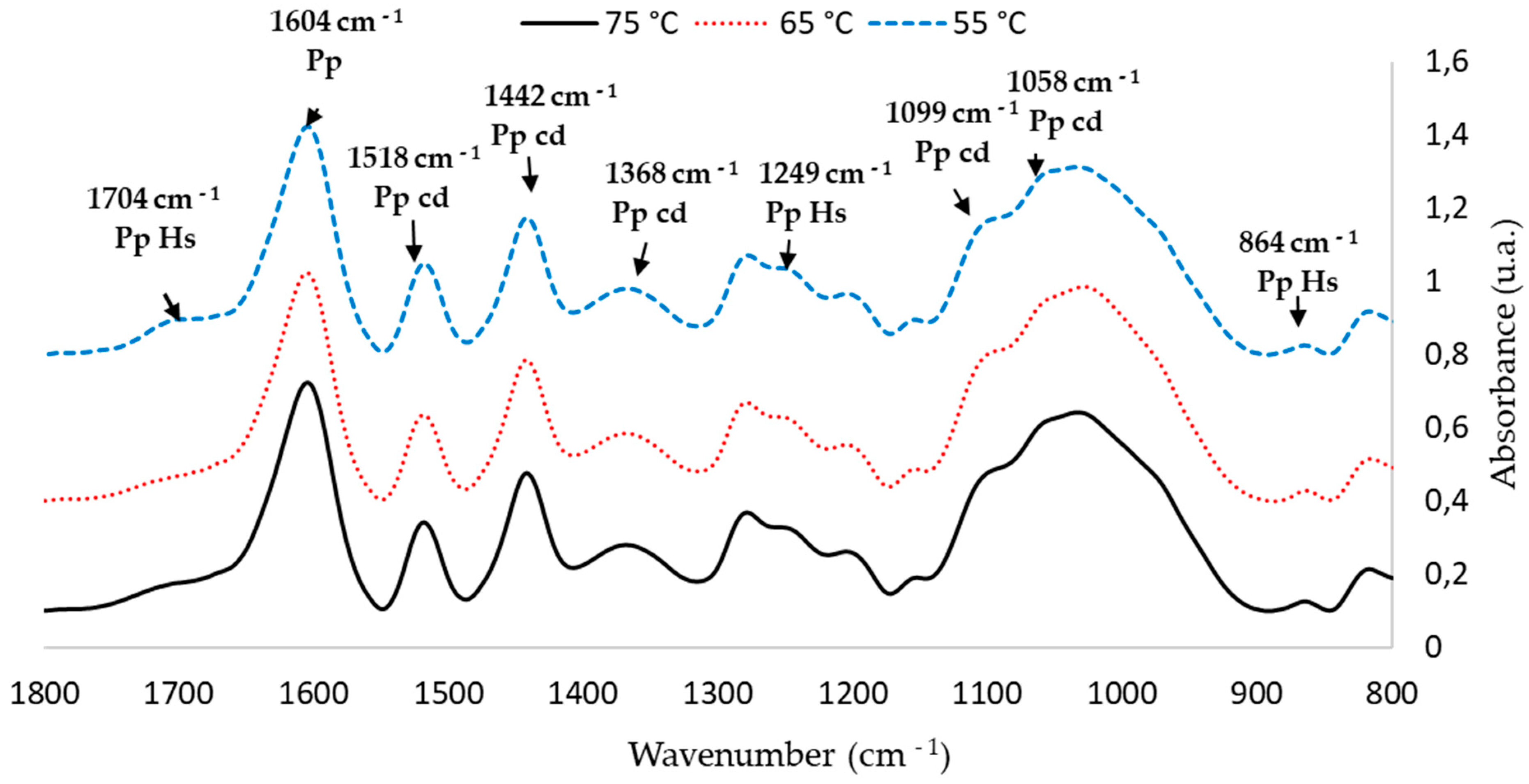
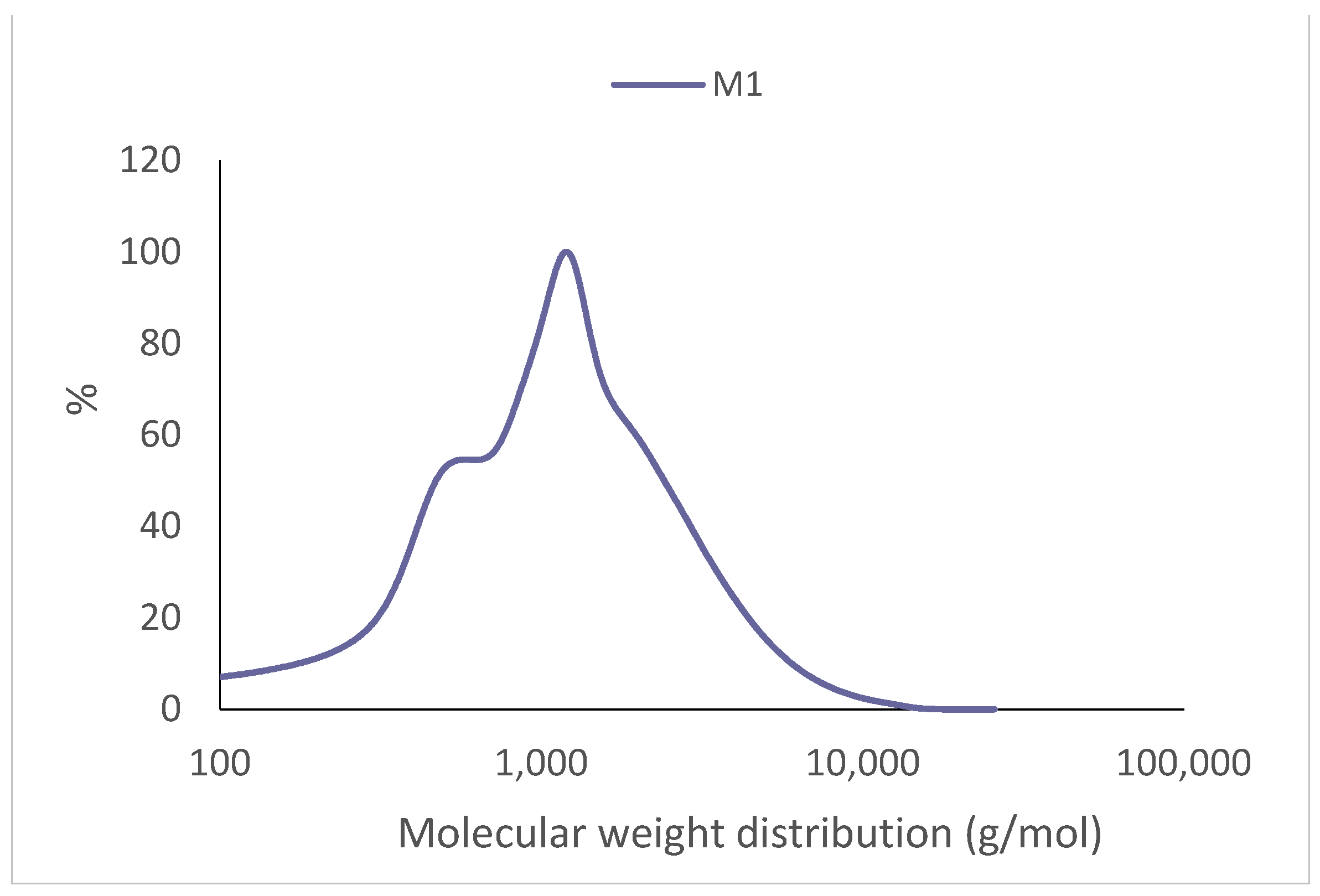
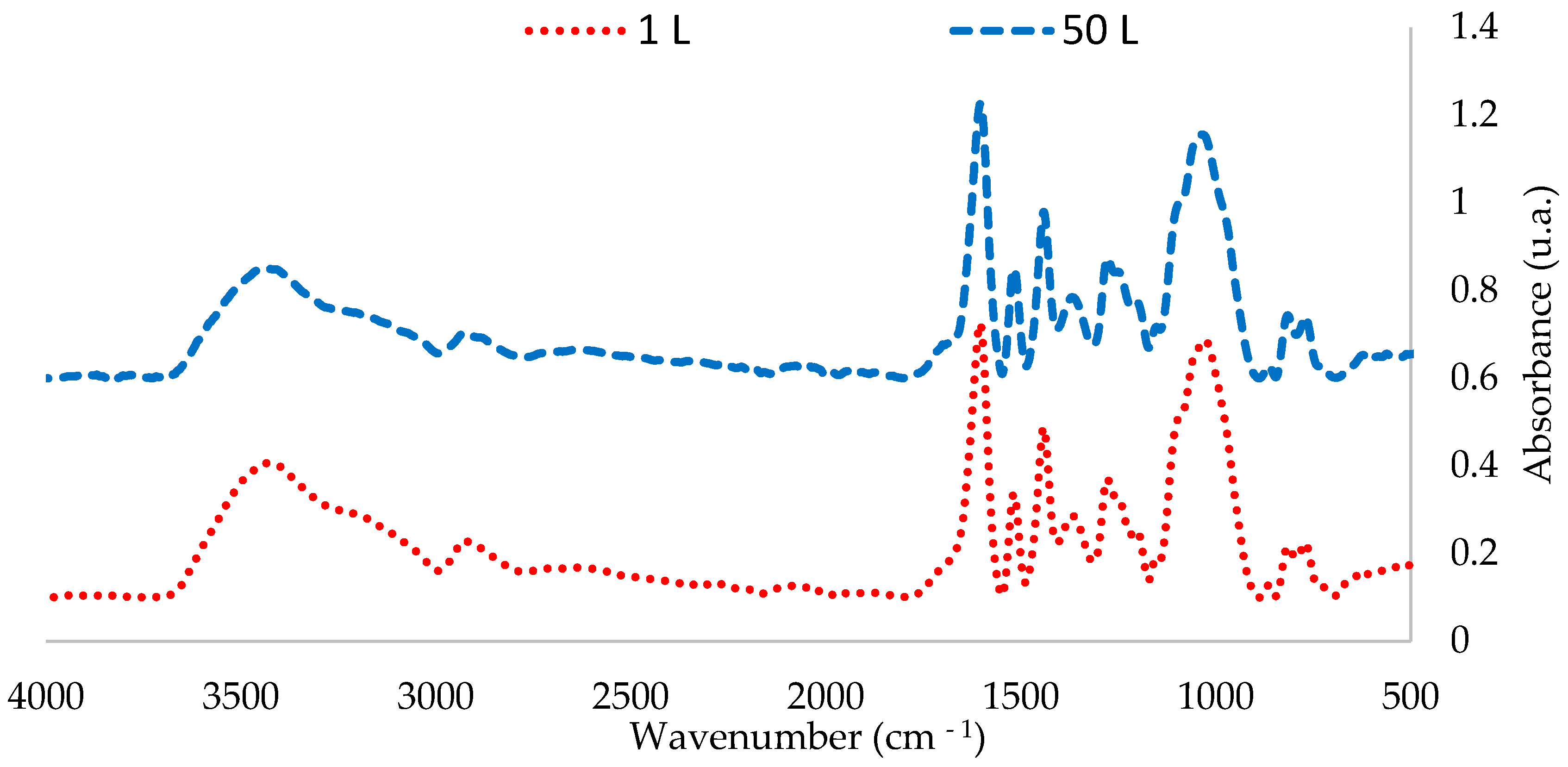
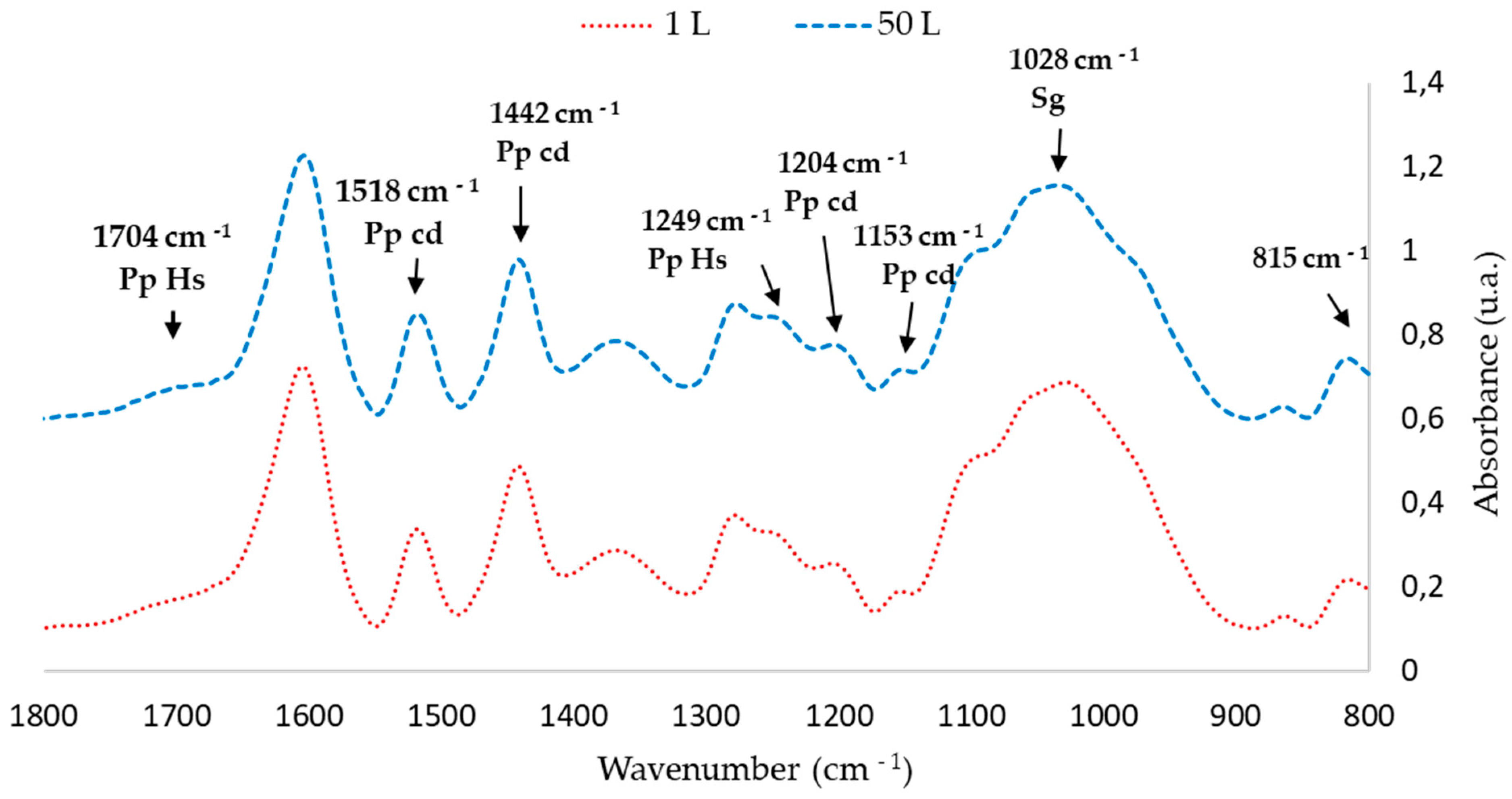

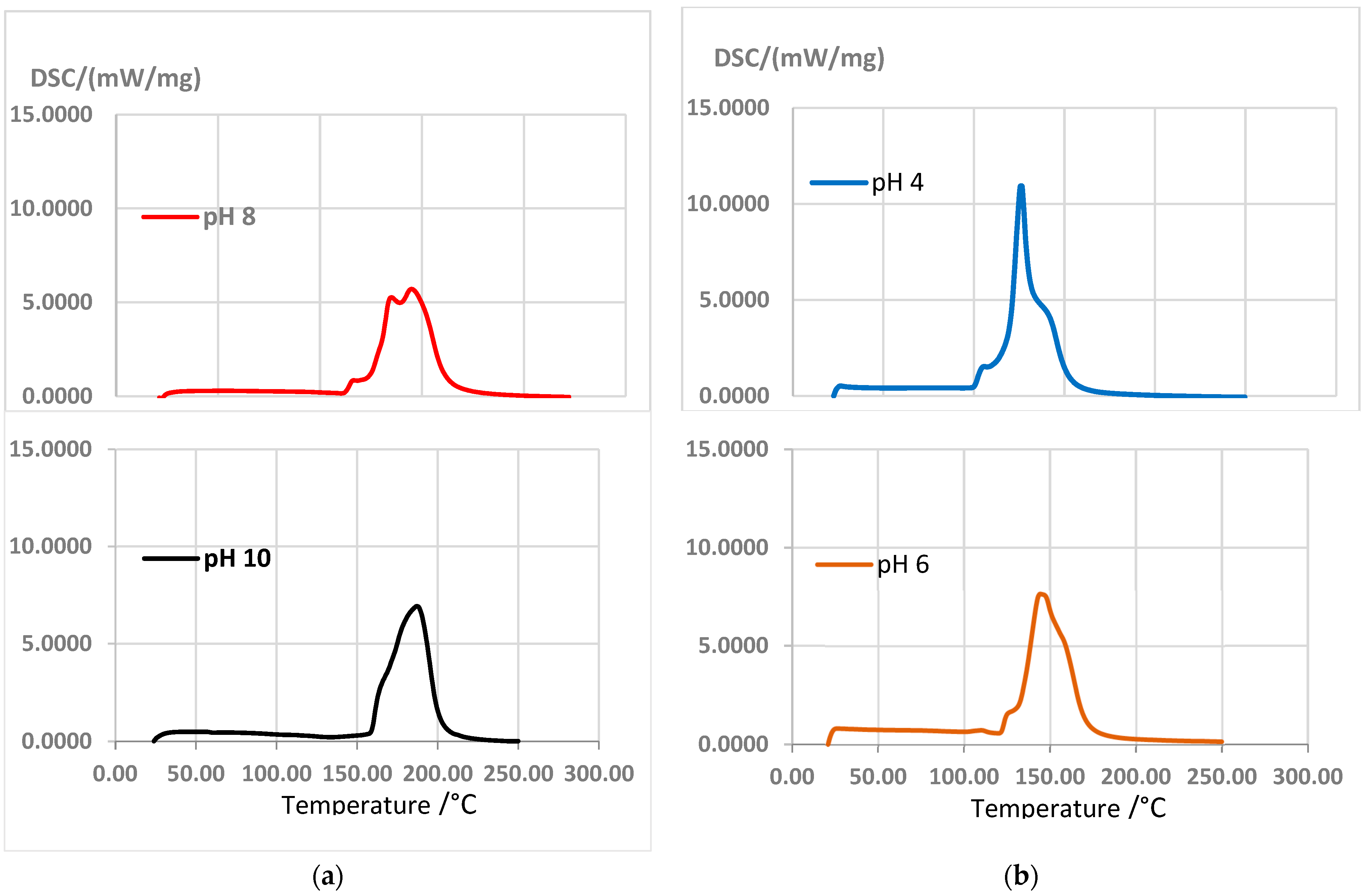
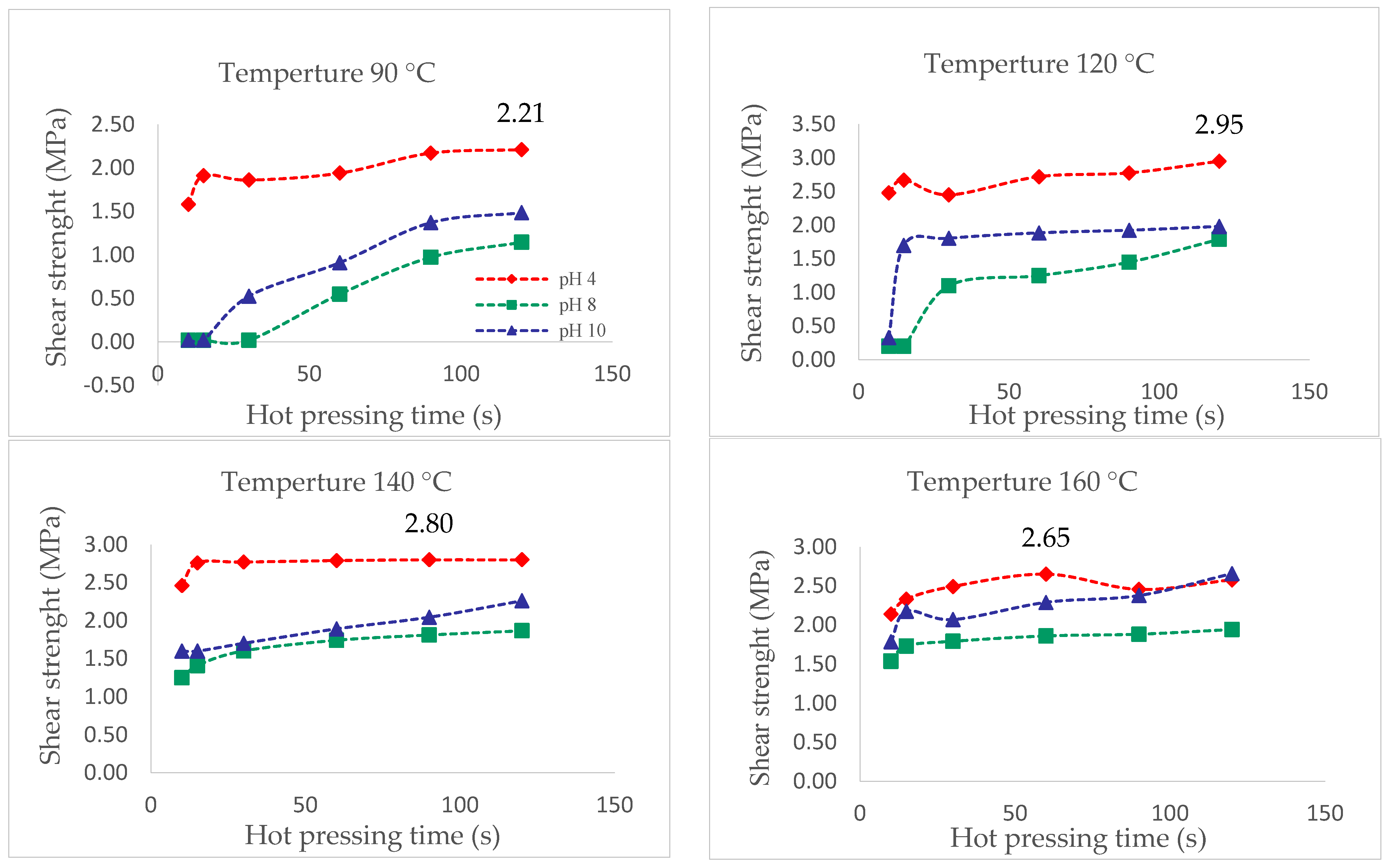
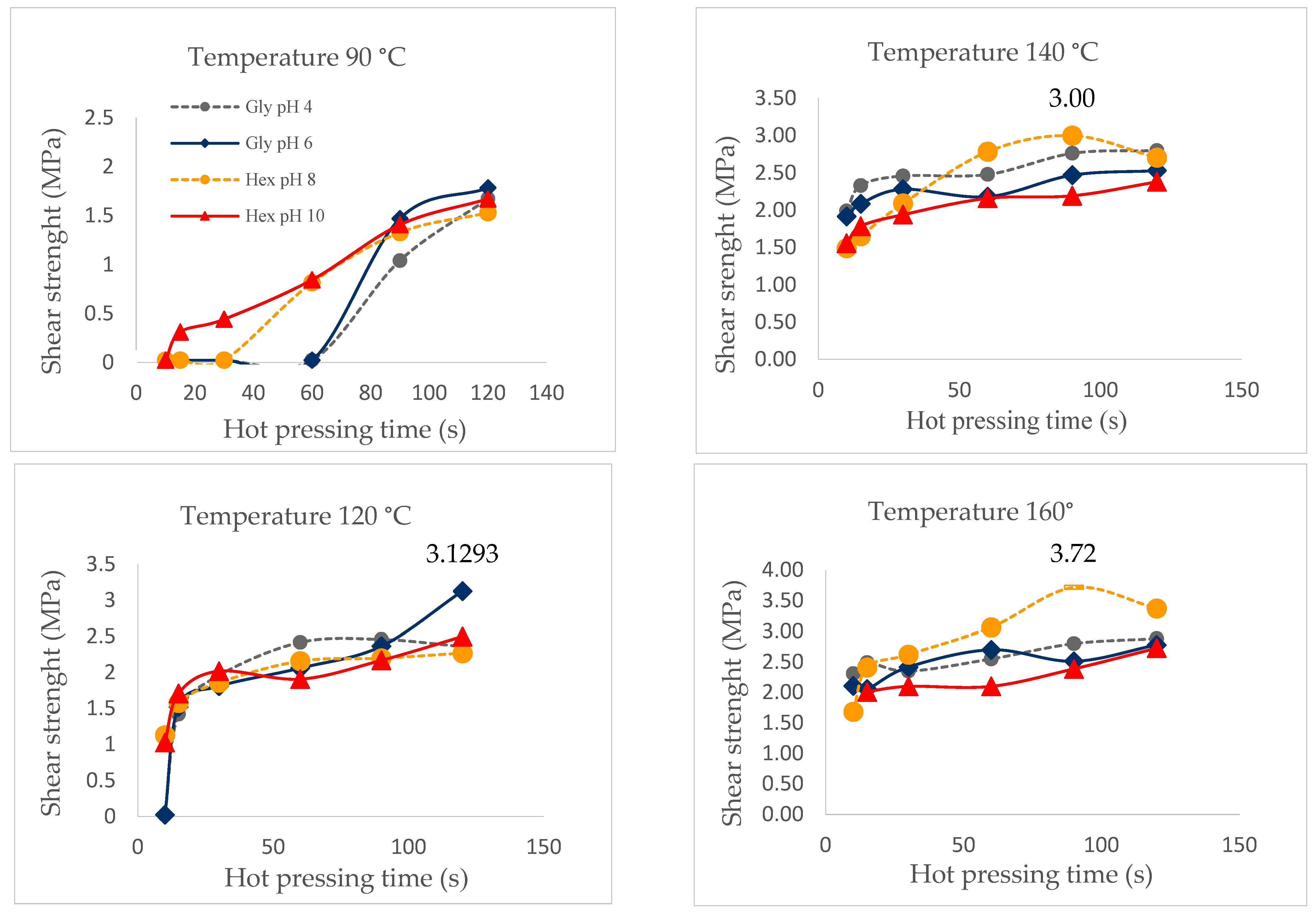
| Independent Variables | |||
|---|---|---|---|
| Test | Solvent | Time(h) | Temperature (°C) |
| 1 | Methanol | 2 | 65 |
| 2 | Methanol | 2 | 75 |
| 3 | Methanol | 4 | 65 |
| 4 | Methanol | 4 | 75 |
| 5 | Ethanol | 2 | 65 |
| 6 | Ethanol | 2 | 75 |
| 7 | Ethanol | 4 | 65 |
| 8 | Ethanol | 4 | 75 |
| Response Variables | ||||||
|---|---|---|---|---|---|---|
| Test | Solvent | Temperature (°C) | Time (h) | Yield Extraction (%) | Condensed Tannins (mg Cyanidin/g Dry Bark) | Stiasny Number (%) |
| 1 | Methanol | 65 | 2 | 19.5 ± 0.99 a | 1.42 ± 1.21 ab | 91 ± 0.03 a |
| 2 | Methanol | 75 | 2 | 12.28 ± 0.26 b | 11.47 ± 0.78 ab | 78 ± 0.59 d |
| 3 | Methanol | 65 | 4 | 20.81 ± 0.45 a | 9.35 ± 1.74 b | 88 ± 0.78 b |
| 4 | Methanol | 75 | 4 | 9.74 ± 0.33 bc | 11.98 ± 2.1 ab | 28 ± 0.27 f |
| 5 | Ethanol | 65 | 2 | 6.01 ± 2.79 c | 9.81 ± 3.28 b | 20 ± 0.99 g |
| 6 | Ethanol | 75 | 2 | 10.50 ± 0.47 bc | 12.64 ± 1.32 ab | 84 ±1.62 c |
| 7 | Ethanol | 65 | 4 | 7.10 ± 0.29 bc | 11.49 ± 2.84 ab | 28 ± 0.10 f |
| 8 | Ethanol | 75 | 4 | 10.48 ± 0.52 bc | 13.40 ± 0.64 a | 36 ± 2.14 e |
| Extraction Temperature (°C) | Yield Extraction (%) | Stiasny Number (%) | Total Polyphenols (mg GAE/g Dry Bark) |
|---|---|---|---|
| 55 | 11.30 ± 0.43 a | 51.1 ±1.55 bc | 42.64 ± 1.16 b |
| 65 | 11.11 ± 0.55 a | 89.6 ± 3.93 a | 55.67 ± 0.14 a |
| 75 | 11.06 ± 1.07 a | 42.9 ± 6.22 c | 44.28 ± 1.02 b |
| 55 °C | 65 °C | 75 °C | Group | Range cm−1 | ||||
|---|---|---|---|---|---|---|---|---|
| cm−1 | Intensity | cm−1 | Intensity | cm−1 | Intensity | |||
| 3431 | 47 | 3433 | 49 | 3441 | 47 | -OH stretch | 3336 | |
| 2927 | 19 | 2928 | 21 | 2930 | 19 | -CH2- asymmetric stretch | 2916–2936 | |
| 2881 | 17 | 2881 | 18 | 2881 | 17 | -CH2- symmetric stretch | 2843–2863 | |
| 1705 | 15 | 1705 | 10 | 1705 | 12 | C=O (Pp Hs) | 1710–1720 | |
| 1604 | 100 | 1605 | 100 | 1604 | 100 | CAR = CAR (Pp) | 1500–1600 | |
| 1518 | 39 | 1518 | 38 | 1518 | 40 | C=C asymmetric stretching aromatic (Pp) | 1510 | |
| 1442 | 60 | 1442 | 62 | 1441 | 60 | C-H bending of CH2 groups (Pp cd) | 1450–1455 | |
| 1368 | 29 | 1368 | 30 | 1367 | 29 | C-C stretch | 1380–1400 | |
| 1278 | 43 | 1278 | 43 | 1278 | 44 | Ph-CHR-OH deformation | 1260–1350 | |
| 1249 | 38 | 1249 | 36 | 1249 | 37 | C-O stretching (Pp Hs) | 1240–1250 | |
| 1204 | 26 | 1204 | 25 | 1204 | 27 | C-H twisting (Pp cd) | 1200 | |
| 1153 | 15 | 1153 | 14 | 1152 | 15 | CAR-O (Pp cd) | 1140–1160 | |
| 1099 | 59 | 1100 | 65 | 1099 | 61 | C-O-C stretch (Pp cd) | 1105 | |
| 1058 | 79 | 1058 | 87 | 1058 | 83 | C-O primary alcohol stretching (Pp cd) | 1060–1070 | |
| 1033 | 87 | 1028 | 94 | 1033 | 82 | C-O, C-C and C-C-O stretch (Sg) Aromatic cycle bending (Pp cd) | 1025–1035 | |
| 1025 | ||||||||
| 864 | 4 | 863 | 5 | 864 | 4 | Aromatic C-H out-of-plane bending (Pp) | 860–870 | |
| 816 | 18 | 815 | 19 | 816 | 19 | C-O-C aromatic ethers, symmetric stretching | 810–850 | |
| 771 | 20 | 771 | 20 | 771 | 21 | C-C alkanes skeletal vibrations | 720–750 | |
| Extraction Temperature (°C) | Yield Extraction (%) | Total Polyphenols (mg GAE/g Dry Bark) | Stiasny Number (%) |
|---|---|---|---|
| 65 | 12.35 ± 2.00 | 40.77 ± 1.78 | 72.8 ± 3.7 |
| Laboratory Scale (1 L) | Pilot Scale (50 L) | Group | Range cm−1 | ||
|---|---|---|---|---|---|
| cm−1 | Intensity | cm−1 | Intensity | ||
| 3433 | 49 | 3434 | 40 | -OH stretch | 3336 |
| 2928 | 21 | 2926 | 17 | -CH2- asymmetric stretch | 2916–2936 |
| 2881 | 18 | 2881 | 15 | -CH2- symmetric stretch | 2843–2863 |
| 1705 | 10 | 1700 | 12 | C=O (Pp Hs) | 1710–1720 |
| 1605 | 100 | 1604 | 100 | CAR = CAR (Pp) | 1500–1600 |
| 1518 | 38 | 1518 | 40 | C=C asymmetric stretching aromatic (Pp) | 1510 |
| 1442 | 62 | 1442 | 61 | C-H bending of CH2 groups (Pp cd) | 1450–1455 |
| 1368 | 30 | 1368 | 30 | C-C stretch | 1380–1400 |
| 1278 | 43 | 1278 | 44 | Ph-CHR-OH deformation | 1260–1350 |
| 1249 | 37 | 1249 | 39 | C-O stretching (Pp Hs) | 1240–1250 |
| 1204 | 25 | 1204 | 28 | C-H twisting (Pp cd) | 1200 |
| 1153 | 14 | 1152 | 19 | CAR-O (Pp cd) | 1140–1160 |
| 1100 | 65 | 1100 | 63 | C-O-C stretch (Pp cd) | 1105 |
| 1058 | 87 | 1058 | 85 | C-O primary alcohol stretching (Pp cd) | 1060–1070 |
| 1028 | 94 | 1035 | 89 | C-O, C-C, and C-C-O stretch (Sg) Aromatic cycle bending (Pp cd) | 1025–1035 |
| 1025 | |||||
| 863 | 5 | 864 | 5 | Aromatic C-H out-of-plane bending (Pp) | 860–870 |
| 815 | 19 | 816 | 23 | C-O-C aromatic ethers. symmetric stretching | 810–850 |
| 771 | 20 | 771 | 20 | C-C Alkanes skeletal vibrations | 720–750 |
| pH | Hardener (%) | Mixed Start Time (min) | Apparent Viscosity (mPa s) | K (Pa sn) | n |
|---|---|---|---|---|---|
| 4 | 0% | 60 | 17 | −0.64 | 0.94 |
| 300 | 30 | −0.46 | 0.97 | ||
| 8 | 0% | 60 | 12 | −0.78 | 0.94 |
| 300 | 18 | −0.64 | 0.94 | ||
| 4 | 12% Gly | 60 | 45 | 0 | 0.86 |
| 300 | 19 | 0 | 1.09 | ||
| 6 | 12% Gly | 60 | 104 | 0.15 | 0.91 |
| 300 | 125 | 0.17 | 0.95 | ||
| 8 | 7% Hex | 60 | 44 | 0 | 0.82 |
| 300 | 42 | 0 | 0.87 | ||
| 10 | 7% Hex | 60 | 455 | 0.65 | 1.02 |
| 300 | 19,632 | 1.40 | 1.07 |
| pH | Hardener (%) | ∆h Total (J/G) | Tg0 (°C) | Tgf (°C) | Tmax. (°C) |
|---|---|---|---|---|---|
| 4 | 0% | 1127 | 98 | 148 | 113.4/139 |
| 8 | 0% | 909 | 108 | 145 | 111.3/117.3 |
| 10 | 0% | 1477 | 122 | 182 | 154.4/164.4/175.5 |
| 4 | 12% Gly | 1080 | 100 | 158 | 126,4 |
| 6 | 12% Gly | 1084 | 125 | 180 | 144.0 |
| 8 | 7% Hex | 841.6 | 160 | 188 | 170.1 |
| 10 | 7% Hex | 677.4 | 150 | 188 | 172.3 |
| Sample | HHV (MJ/kg) | Ash (Dry Base %) | Volatile Matter (Dry Base %) |
|---|---|---|---|
| Not extracted | 21.5 ± 60 | 0.93 ± 0.02 | 74.3 ± 0.27 |
| Extracted | 18.7 ± 65 | 0.72 ± 0.05 | 75.3 ± 0.90 |
Disclaimer/Publisher’s Note: The statements, opinions and data contained in all publications are solely those of the individual author(s) and contributor(s) and not of MDPI and/or the editor(s). MDPI and/or the editor(s) disclaim responsibility for any injury to people or property resulting from any ideas, methods, instructions or products referred to in the content. |
© 2023 by the authors. Licensee MDPI, Basel, Switzerland. This article is an open access article distributed under the terms and conditions of the Creative Commons Attribution (CC BY) license (https://creativecommons.org/licenses/by/4.0/).
Share and Cite
Serrentino, P.; Santos, J.; Fuentealba, C.; Hernandez-Mena, L.; Mary, A.; Ibañez, C.M. Valorization of Uruguayan Pinus elliottii Bark by Developing Sustainable Adhesives. Forests 2023, 14, 1184. https://doi.org/10.3390/f14061184
Serrentino P, Santos J, Fuentealba C, Hernandez-Mena L, Mary A, Ibañez CM. Valorization of Uruguayan Pinus elliottii Bark by Developing Sustainable Adhesives. Forests. 2023; 14(6):1184. https://doi.org/10.3390/f14061184
Chicago/Turabian StyleSerrentino, Paola, Jorge Santos, Cecilia Fuentealba, Laidy Hernandez-Mena, Alvaro Mary, and Claudia Marcela Ibañez. 2023. "Valorization of Uruguayan Pinus elliottii Bark by Developing Sustainable Adhesives" Forests 14, no. 6: 1184. https://doi.org/10.3390/f14061184
APA StyleSerrentino, P., Santos, J., Fuentealba, C., Hernandez-Mena, L., Mary, A., & Ibañez, C. M. (2023). Valorization of Uruguayan Pinus elliottii Bark by Developing Sustainable Adhesives. Forests, 14(6), 1184. https://doi.org/10.3390/f14061184







